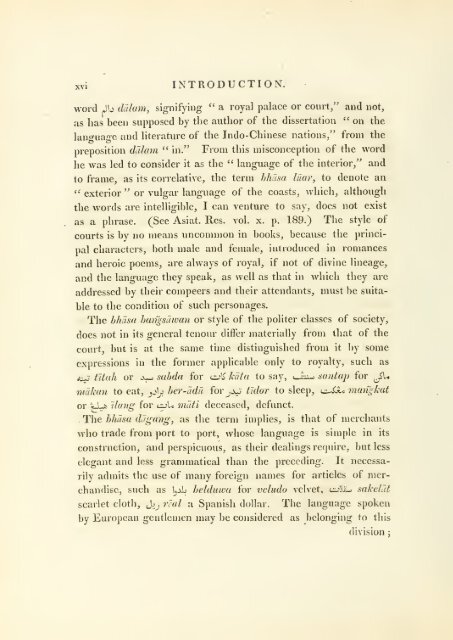A grammar of the Malayan language, with an introduction and praxis..
A grammar of the Malayan language, with an introduction and praxis..
A grammar of the Malayan language, with an introduction and praxis..
You also want an ePaper? Increase the reach of your titles
YUMPU automatically turns print PDFs into web optimized ePapers that Google loves.
XVI<br />
INTRODUCTION.<br />
word Jb dulam, signifying " a royal palace or court," <strong>an</strong>d not,<br />
as has been supposed by <strong>the</strong> author <strong>of</strong> <strong>the</strong> dissertation " on <strong>the</strong><br />
<strong>l<strong>an</strong>guage</strong> <strong>an</strong>d literature <strong>of</strong> <strong>the</strong> Indo-Chinese nations," from <strong>the</strong><br />
preposition dulam " in." From this misconception <strong>of</strong> <strong>the</strong> word<br />
he was led to consider it as <strong>the</strong> " <strong>l<strong>an</strong>guage</strong> <strong>of</strong> <strong>the</strong> interior," <strong>an</strong>d<br />
to frame, as its correlative, <strong>the</strong> term hhasa luar, to denote <strong>an</strong><br />
" exterior " or vulgar <strong>l<strong>an</strong>guage</strong> <strong>of</strong> <strong>the</strong> coasts, which, although<br />
<strong>the</strong> woids are intelligible, I c<strong>an</strong> venture to say, does not exist<br />
as a phrase. (See Asiat. Res. a^oI. x. p. 189.) The style <strong>of</strong><br />
courts is by no me<strong>an</strong>s imcommon in books, because <strong>the</strong> princi-<br />
pal characters, both male <strong>an</strong>d female, iiitroduced in rom<strong>an</strong>ces<br />
<strong>an</strong>d heroic poems, are always <strong>of</strong> royal, if not <strong>of</strong> divine lineage,<br />
<strong>an</strong>d <strong>the</strong> <strong>l<strong>an</strong>guage</strong> <strong>the</strong>y speak, as well as that in which <strong>the</strong>y are<br />
addressed by <strong>the</strong>ir compeers <strong>an</strong>d <strong>the</strong>ir attend<strong>an</strong>ts, must be suita-<br />
ble to <strong>the</strong> condition <strong>of</strong> such personages.<br />
The Lhasa haiigsaw<strong>an</strong> or style <strong>of</strong> <strong>the</strong> politer classes <strong>of</strong> society,<br />
does not in its general tenour differ materially from that <strong>of</strong> <strong>the</strong><br />
court, but is at <strong>the</strong> same time distinguished from it by some<br />
expressions in <strong>the</strong> former applicable only to royalty, such as<br />
li^ tltah or ju-o sahda for cj\^ kata to say, u-Lwj s<strong>an</strong>tap for ^^U<br />
mdJc<strong>an</strong> to eat, jj>^ her-adu for jj^j tldor to sleep, c:,Xvo m<strong>an</strong>gkat<br />
or i_L& il<strong>an</strong>g for cijU miiti deceased, defunct.<br />
The hhasa diigung, as <strong>the</strong> term implies, is that <strong>of</strong> merch<strong>an</strong>ts<br />
who trade from port to port, whose <strong>l<strong>an</strong>guage</strong> is simple in its<br />
construction, <strong>an</strong>d perspicuous, as <strong>the</strong>ir dealings require, but less<br />
eleg<strong>an</strong>t <strong>an</strong>d less grammatical th<strong>an</strong> <strong>the</strong> preceding. It necessa-<br />
rily admits <strong>the</strong> use <strong>of</strong> m<strong>an</strong>y foreign names for articles <strong>of</strong> mer-<br />
ch<strong>an</strong>dise, such as \^Ai heldiiwa for veludo velvet, aAJL> sakelut<br />
scarlet cloth, Jjj real a Sp<strong>an</strong>ish dollar. The <strong>l<strong>an</strong>guage</strong> spoken<br />
by Europe<strong>an</strong> gentlemen may be considered as belonging to this<br />
division ;

















